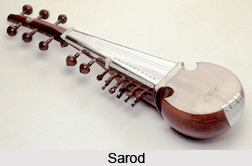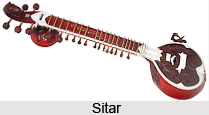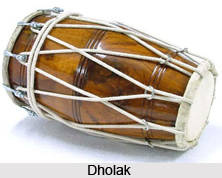The sketch of Indian Culture remains incomplete without music. Since ancient times, the world of music has expanded with the emergence of new forms and styles of music. Instruments accompanying the music have also played a critical role in augmenting its essence. Musical Instruments of Medieval India had become quite popular and have brought about new dimensions in the Indian music. They have enriched the cultural heritage of India.
Rubab
Rabab is a famous musical instrument of medieval India that resembles a lute. It originated through Persian influence. Rabab is made up of a single piece of wood and animal skin is used to form the head and strings of the instruments. At one end of the instrument, a spike is present for balancing. Rabab can be played with the aid of a bow or by plucking with hands and has three main melody strings. However, with time and development of musical instruments, Rabab was gradually replaced by violin as Rabab had a limited range.
 Sarod
Sarod
Sarod belongs to the same musical family as Rabab. An intense and deep sound is produced by Sarod and continuous slides between the musical notes can be created with it. A small tool, made of bones, is used to produce melodies by plucking the strings. The instrument gained much popularity in northern India.
Tambura
Tambura is another musical instrument belonging to medieval era. It is plucked lute instrument having a long neck. The instrument has four to five strings which creates different pitches when combined with Tambura of different sizes. It is made with a hollowed wood or a gourd. Jackwood is most commonly used for making Tamburas.
 Sitar
Sitar
Sitar is a plucked musical instrument which originated in the medieval period. Sympathetic strings on Sitar are used to produce resonance. It is made of a gourd chamber and a long hollow neck which is composed of wood. Precise tuning is required in Sitar to produce beautiful melodies.
Dilruba
Dilruba is a famous musical instrument of medieval India which was prevalent mainly in north-west India. It has a long neck having 18 strings. The instrument is tuned in a similar fashion to sitar. However Dilruba is played only with one main string. A number of sympathetic strings are also present in it.
Pakhavaj
Pakhavaj is percussion instrument and a descendent of ancient instrument Mridangam. It is a two headed drum having a barrel shape. It is used extensively to accompany dance and music performances. The rhythms are played in this instrument with series mnemonic syllables.
 Dholak
Dholak
Dholak is basically a folk instrument of medieval India. It is a two headed drum and the pitch depends on the size of the instrument. Dholak is extensively used along with kirtan, bhangra and qawwali.
Other Musical Instruments of Medieval India
In addition to these, other Musical Instruments of Medieval India are Veena, Sarangi, Mayuri, Tabla, Nakkara, Bansuri, Been etc.
Musical Instruments of Medieval India have undergone great transformations through years. These instruments have added vigour to the traditions and culture of India and have been a significant part of the lives of Indians.




